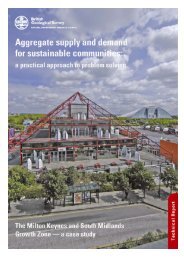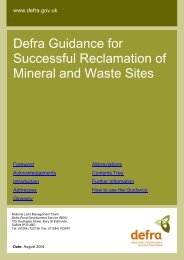creating environmental improvements through biodiversity
creating environmental improvements through biodiversity
creating environmental improvements through biodiversity
You also want an ePaper? Increase the reach of your titles
YUMPU automatically turns print PDFs into web optimized ePapers that Google loves.
Sustainable Aggregates Creating Environmental Improvements <strong>through</strong> Biodiversity<br />
Site: England, including various case studies <strong>through</strong>out the country<br />
Project Aims:<br />
To explain the context and rationale for action on <strong>biodiversity</strong>, including BAPs<br />
To explore the potential relevance of the UK BAP to the minerals industry<br />
To present examples of best practice<br />
To propose targets and actions for the minerals industry and English Nature<br />
To provide a list of references and contacts on Biodiversity Action Plans<br />
To consider how efforts of the minerals industry to contribute to nature conservation may be guided or refocused<br />
by the target-led BAP approach to this<br />
Main Methods:<br />
Desk review of context, legislation, opportunities, monitoring methods and case studies, relating to minerals<br />
industry actions for <strong>biodiversity</strong><br />
Output:<br />
Report providing:<br />
Important background and guidance for the minerals industry on their potential contribution to BAP targets<br />
Information on specific habitats, species and EN programmes likely to be relevant to mineral workings<br />
Review of a sample of Local BAPs and their effects – more detailed LBAPs leading to identification of more<br />
specific actions and roles for different bodies<br />
Emphasis that the BAP and LBAP process should involve partnerships and communication within and<br />
between organisations and communities<br />
Review of development plans and development control relating to the industry’s contribution to UK BAP, and<br />
guidance on Environmental Assessment procedures (to include monitoring)<br />
Examples of good practice using case studies<br />
Information on practical actions that minerals companies can take at different stages of an operation<br />
(including auditing, land management techniques, monitoring and reviewing) to:<br />
• avoid damaging existing habitats<br />
• enhance or create habitats at a site<br />
Sets of recommended objectives and associated actions for the minerals industry, EN and other partners,<br />
including to:<br />
• provide a formal basis for promotion of <strong>biodiversity</strong> across the industry<br />
• promote understanding of the concept of <strong>biodiversity</strong>, and local and national initiatives, <strong>through</strong>out and<br />
beyond the industry<br />
• develop a strategic industry approach to championing species (and perhaps habitats) for which Action<br />
Plans have been prepared<br />
• carry out site / company <strong>biodiversity</strong> audits and act on the findings<br />
• become more involved with LBAPs, LEAPs and LA21 initiatives, and identify priorities for action<br />
Recommendation that more detailed advice is given to the minerals industry on the part they can play in<br />
heavily worked EN Natural Areas<br />
Recommendation that LBAP authors pay more attention to the potential role of the minerals industry<br />
References and contacts relevant to the report (contacts not included in our copy)<br />
Impacts (Actual):<br />
The report provides good background for the minerals industry on the opportunities and obligations it has<br />
in relation to <strong>biodiversity</strong>. It also lays out actions that should be taken by EN and other partners (e.g. local<br />
52

















